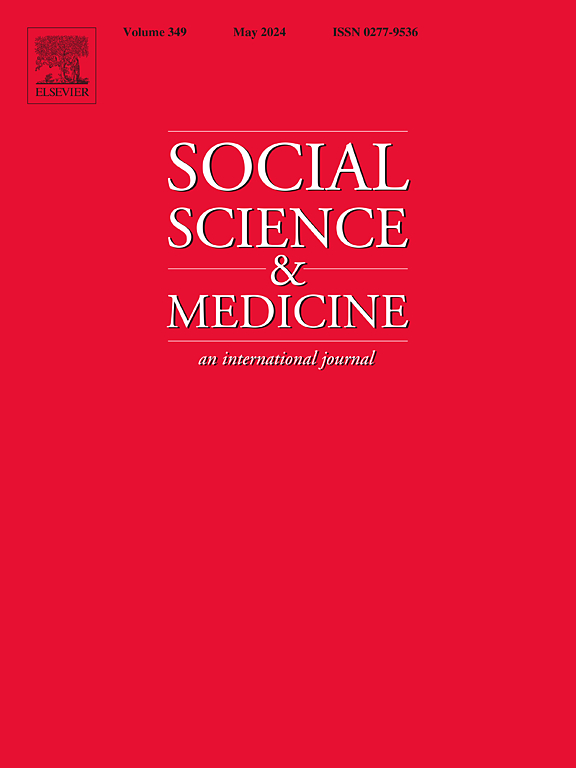Depression trajectories from mid to late life (50–89 Years): The roles of cohort, multimorbidity status, and national contexts across nine European countries
IF 5
2区 医学
Q1 PUBLIC, ENVIRONMENTAL & OCCUPATIONAL HEALTH
引用次数: 0
Abstract
Objectives
This study aims to disentangle the age and cohort effects on depressive symptoms among middle-aged and older adults, while accounting for the role of multimorbidity across nine European countries.
Methods
Using longitudinal data from the Survey of Health, Ageing, and Retirement in Europe (SHARE) (2004–2022), with participants aged 50–89 and birth cohorts from 1921 to 1970, we employed Hierarchical Age-Period-Cohort (HAPC)-Growth Curve models to estimate age and cohort effects on depressive symptoms. Interaction effects of multimorbidity and country with cohort and age were also tested. Bounding analysis was used as a robustness check.
Results
The age effect revealed a U-shaped trajectory of depressive symptoms, with a decline after age 50, reaching a low point around age 65, followed by a sharp increase after age 70. The cohort effect showed that later-born cohorts experienced higher levels of depression. Bounding analysis confirmed these findings: period effects were near zero, with the exception of Spain. Multimorbidity was positively associated with depression, with significant national differences. Younger cohorts with multimorbidity status in Scandinavian countries show elevated depressive symptoms. For Spain, depressive symptoms are concentrated among earlier-born cohorts. Central European countries showed variability, but Germany's depression trajectory remained stable, with cohort effects being most pronounced.
Discussion
Our findings emphasize the need for a life-course perspective to understand depression trajectories. Cohort differences highlight the role of sociohistorical contexts, while multimorbidity requires attention in long-term healthcare policy.
从中年到晚年(50-89岁)的抑郁轨迹:9个欧洲国家的队列、多病状态和国家背景的作用
本研究旨在解开年龄和队列对中老年人抑郁症状的影响,同时考虑9个欧洲国家多病的作用。方法使用来自欧洲健康、老龄化和退休调查(SHARE)(2004-2022)的纵向数据,参与者年龄为50-89岁,出生队列为1921 - 1970年,我们采用分层年龄-时期-队列(HAPC)-增长曲线模型来估计年龄和队列对抑郁症状的影响。多重发病率和国家与队列和年龄的相互作用效应也被检验。使用边界分析作为稳健性检查。结果年龄对抑郁症状的影响呈u型曲线,50岁后抑郁症状下降,65岁左右达到最低点,70岁后抑郁症状急剧上升。队列效应表明,晚出生的队列经历了更高程度的抑郁。边界分析证实了这些发现:除了西班牙之外,周期效应几乎为零。多病与抑郁症呈正相关,且存在显著的国家差异。斯堪的纳维亚国家多病状态的年轻队列显示抑郁症状升高。在西班牙,抑郁症状集中在出生较早的人群中。中欧国家表现出变化,但德国的萧条轨迹保持稳定,队列效应最为明显。讨论:我们的发现强调需要从生命历程的角度来理解抑郁的轨迹。队列差异突出了社会历史背景的作用,而多发病需要长期医疗保健政策的关注。
本文章由计算机程序翻译,如有差异,请以英文原文为准。
求助全文
约1分钟内获得全文
求助全文
来源期刊

Social Science & Medicine
PUBLIC, ENVIRONMENTAL & OCCUPATIONAL HEALTH-
CiteScore
9.10
自引率
5.60%
发文量
762
审稿时长
38 days
期刊介绍:
Social Science & Medicine provides an international and interdisciplinary forum for the dissemination of social science research on health. We publish original research articles (both empirical and theoretical), reviews, position papers and commentaries on health issues, to inform current research, policy and practice in all areas of common interest to social scientists, health practitioners, and policy makers. The journal publishes material relevant to any aspect of health from a wide range of social science disciplines (anthropology, economics, epidemiology, geography, policy, psychology, and sociology), and material relevant to the social sciences from any of the professions concerned with physical and mental health, health care, clinical practice, and health policy and organization. We encourage material which is of general interest to an international readership.
 求助内容:
求助内容: 应助结果提醒方式:
应助结果提醒方式:


